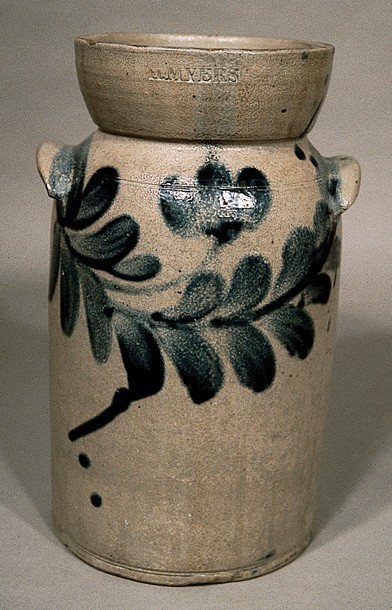
Newspaper advertisement for china merchant William Myers’s Baltimore Stoneware Manufactory, October 13, 1812. This is the first known reference to Henry Remmey in Baltimore.

Henry Remmey’s Baltimore maker’s mark. (All photos, Luke Zipp.) Since Remmey never owned his own stoneware pottery in Baltimore, he probably produced stoneware bearing this mark at the Baltimore Stoneware Manufactory under Jacob Myers, 1818–1821, although an earlier date for this stoneware is possible.

Mark used on stoneware made at the Baltimore Stoneware Manufactory under Henry Myers’s ownership. Henry Remmey superintended the manufactory from 1821 to 1829.

Newspaper advertisement and price list for merchant Henry Myers’s stoneware manufactory, July 3, 1823. Not only does this advertisement serve as proof that Henry Remmey and Henry Remmey Jr. manufactured “H. MYERS” stoneware, but it also clarifies the types of stoneware they produced for Myers.

Newspaper advertisement announcing the opening of merchant George Earnest’s stoneware manufactory, August 14, 1824. According to this ad, Earnest secured Henry Remmey Jr. as the superintendent of his new pottery.

Jar, Henry Remmey, Baltimore, 1812–1821. Salt-glazed stoneware. H. 15". (Private collection.) Impressed “H. REMMEY / BALTIMORE,” this storage jar has a form identical to examples made in Manhattan in the early nineteenth century. The cobalt decoration is typical of Remmey’s earlier Baltimore work.

Pitcher, Henry Remmey, Baltimore, 1812–1821. Salt-glazed stoneware. H. 11Ω". (Private collection.) The pitcher’s decorative motif, vibrant cobalt, and pure gray clay are typical of Remmey’s Baltimore stoneware. The impressed “H. REMMEY / bALTIMORE” mark is illustrated in fig. 2

Wine cooler, Baltimore, ca. 1815. Salt-glazed stoneware. H. 11". (Private collection.) Although unsigned, this keg was almost certainly made by Henry Remmey in Baltimore. The keg form is rarely seen in Baltimore stoneware but is not uncommon in Manhattan stoneware.

Pitcher, Henry Remmey, Baltimore, 1812–1821. Salt-glazed stoneware. H. 11". (Private collection.) Impressed “H. REMMEY / BALTIMORE,” this pitcher, with its incised bird decoration, displays Remmey’s command of incising. He included fine details of the birds and flowering trees, and washed the decoration with vibrant cobalt confined almost entirely within the incised lines.

Ink bottle, Henry Remmey, Baltimore, 1812–1821. Salt-glazed stoneware. H. 5". (Private collection.) The type used in the “H. REMMEY” mark on this bottle is the same as that used on the “H. REMMEY / BALTIMORE” stamp. This comparison, combined with the clay color of the bottle, confirms a Baltimore attribution.

Cooler, Henry Myers, Baltimore, 1821–1829. Salt-glazed stoneware. H. 16". (Courtesy, Olde Hope Antiques, Inc.) Impressed “H. MYERS,” this incised bird-decorated vessel is referred to as a “Spicket Jug” in Myers’s price lists. Certainly made by Remmey while working for Myers, the close link between the decoration on this piece and “H. REMMEY / BALTIMORE” stoneware suggests that this cooler was probably made by Remmey toward the beginning of Henry Myers’s tenure. The form of the bird as well as the quality of incising are similar to the pitcher illustrated in fig. 9. A fine flowering-vine decoration on the reverse of the cooler matches Remmey’s early decorative motifs.

Jars, Henry Myers, Baltimore, 1821–1829. Salt-glazed stoneware. H. 15". (Private collection.) These impressed “H. MYERS” jars were manufactured while Henry Remmey worked for Myers and reflect Remmey’s shift toward mass production. The forms are simpler than those seen in his earlier wares and the decoration is less finely executed

Pitchers, Henry Myers, Baltimore, 1821–1829. Salt-glazed stoneware. H. 10 1/2". (Private collection.) Both of these pitchers are impressed “H. MYERS” and reflect Remmey’s standardization of this form under Henry Myers. The pitcher on the left displays Remmey’s standard “H. MYERS” brushed cobalt decoration. The decoration on the pitcher at right shows up on Remmey Philadelphia stoneware and possibly was made by Henry Remmey Jr

Jug, Henry Myers, Baltimore, 1821–1829. Salt-glazed stoneware. H. 15". (Private collection.) Although undecorated, this impressed “H. MYERS” jug is elaborate for its form. An ovoid shape and incising at the base and neck add to the visual appeal of this vessel.

Milk pan, Henry Myers, Baltimore, 1821–1829. Salt-glazed stoneware. D. 9 3/4". (Private collection.) This milk pan, impressed “H. MYERS,” bears a variation of Remmey’s standard decoration.

Churn, Henry Myers, Baltimore, 1821–1829. Salt-glazed stoneware. H. 12 1/2". (Private collection.) Impressed “H. MYERS.” Although not a standard production item at the Henry Myers pottery, stoneware churns are not unusual in Baltimore stoneware.

Flowerpot, Baltimore, ca. 1820. Salt-glazed stoneware. H. 7". (Private collection.) Excavated in Baltimore City (part of the bird at left has been restored), this incised bird-decorated flowerpot was almost certainly made by Henry Remmey Jr. in Baltimore. While its clay and cobalt color substantiate its Baltimore origin, the flowerpot’s incising is very similar to incising found on Remmey Jr.’s Philadelphia stoneware.

Reverse of the flowerpot illustrated in fig. 17.
